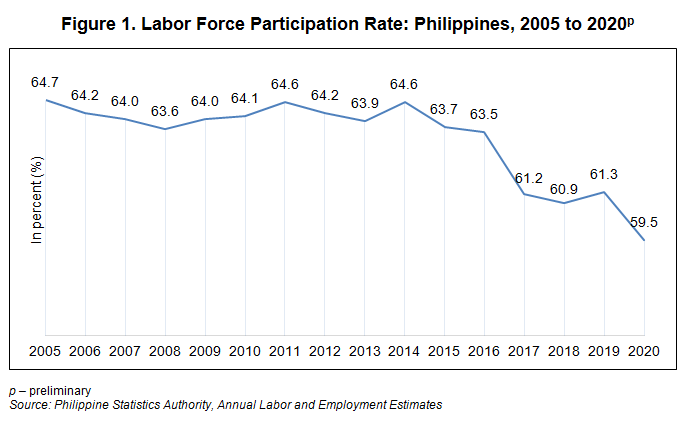
In 2020, the number of persons who were in the labor force was estimated at 43.9 million. This number represents the economically active population, either employed or unemployed, accounting for 59.5 percent labor force participation rate (LFPR) of the 73.7 million population 15 years old and over. This translates to three in every five of the population 15 years and over who were either employed or unemployed. This annual LFPR is lowest since the adoption of the new definition of unemployed in April 2005, reflecting the effect of the various community quarantine restrictions, business closures, and physical distancing measures that were put in place in the Philippines starting March 2020 amidst the Coronavirus disease 2019 (COVID-19) pandemic. (Table A, and Figure 1)
The annual unemployment rate in 2020 rose to 10.3 percent accounting for 4.5 million unemployed Filipinos in the labor force. This is the highest recorded annual unemployment rate since April 2005. In 2019, unemployment rate registered at 5.1 percent. (Tables A, and 3)
The employment rate, or the proportion of employed persons to the total labor force, fell from 94.9 percent in 2019 to 89.7 percent or equivalent to 39.4 million total employed persons in 2020. (Tables A, and 1)

Workers were grouped into three broad sectors, namely, agriculture, industry, and services sector. Workers in the services sector comprised most of the employed persons accounting for 56.9 percent share in 2020. In 2019, the proportion of employed persons is also largest in the services sector at
In terms of number of workers, the agriculture sector was the second largest group with 24.8 percent share, while the industry sector accounted for the smallest contributing sector with 18.3 percent share. In 2019, workers in the agriculture sector and the industry sector constituted the 22.2 percent, and
By major occupation group, workers in the elementary occupations were the largest employed group both in 2020 (27.2%) and in 2019 (26.5%). Service and sales workers comprised the second largest occupation group (19.3%) in 2020, followed by skilled agricultural, forestry, and fishery workers (13.4%). (Table 1)
Employed persons fall into any of these classes of workers: (1) wage and salary workers; (2) self-employed workers without any paid employee; (3) employers in own family-operated farm or business; and (4) unpaid family workers. Wage and salary workers are those who work for private households, private establishments, government, and government-controlled corporations, and those who work with pay in own family-operated farm or business.
In 2020, the wage and salary workers remained the class of workers with the largest share at 62.9 percent, which was estimated at 64.6 percent in 2019. Among the wage and salary workers, those in private establishments accounted for the highest share (48.9%), followed by workers in government and government-controlled corporations (9.5%), workers in private households (4.2%), and workers with pay in own family-operated farm or business (0.3%). Further, the share of self-employed without any paid employee to the total employed was 28.3 percent, which registered at 26.8 percent in 2019. (Table 1)
Employed persons at work are classified as either full-time workers or part-time workers. Full-time workers refer to those who work for 40 hours or more in a week, while part-time workers are those who work for less than 40 hours. Of the total employed persons in 2020, 55.9 percent were full-time workers, slightly lower than the estimated share of 69.3 percent in 2019. Part-time workers registered a higher share of 34.5 percent in 2020 from the 29.9 percent recorded in 2019. Further, 9.6 percent of the employed persons are currently employed but not at work in 2020, higher than the 0.8 percent share in 2019, due to various working time arrangements, temporary illness/injury, vacation or other leave of absence, bad weather, or strike/labor dispute. The average number of hours worked per week was 39.4 hours which was lower than the estimated 42.1 hours in 2019. (Table 1)
Employed persons who express their desire to have additional hours of work in their present job or to have additional job, or to have a new job with longer working hours are considered underemployed. In 2020, the total underemployed was estimated at 6.4 million corresponding to an underemployment rate of 16.2 percent. In 2019, the underemployment rate was higher at 13.8 percent. Underemployed persons who worked for less than 40 hours in a week are called visibly underemployed persons. This accounted for 60.0 percent of the total underemployed in 2020, which was lower in 2019 at 57.6 percent. Those who worked for 40 hours or more in a week comprised the 29.4 percent in 2020, and the 41.0 percent in 2019. (Tables A and 2)
Across the broad sectors, majority (48.2%) of the underemployed persons worked in the services sector, followed by the agriculture sector (33.4%), and the industry sector (18.4%). (Table 2)
In 2020, the regional unemployment rates based on the estimated 4.5 million unemployed persons showed double digit percent shares in the following regions: Ilocos Region (13.4%), Central Luzon (13.1%), National Capital Region (11.7%), CALABARZON (11.6%), Cordillera Administrative Region (10.4%), and Central Visayas (10.3%). (Table 4)
Unemployed persons were highest in the age group 15 to 34 years old at 65.7 percent. Moreover, a higher share of the unemployed persons is constituted by males with 63.8 percent as compared to females with 36.2 percent share. By highest grade completed, 28.6 percent of the total unemployed completed junior high school, and 22.4 percent were college graduates. (Table 3)
DENNIS S. MAPA, Ph.D.
Undersecretary
National Statistician and Civil Registrar General
